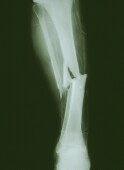 There is a simple method for determining if a bone is broken, without the use of any instruments. A bone will reliably maintain a certain degree of stiffness, unless it is broken. Utilizing the inherent stiffness differences between broken and unbroken bones, a light pain response test can be used to check a bone's integrity.
There is a simple method for determining if a bone is broken, without the use of any instruments. A bone will reliably maintain a certain degree of stiffness, unless it is broken. Utilizing the inherent stiffness differences between broken and unbroken bones, a light pain response test can be used to check a bone's integrity.
When an injured bone is unbroken, acute pain will be observed directly at the impact site; whereby the pain rapidly decreases in proportion to the distance from the injury. Gentle poking with a finger is all that is needed for this test.
On the other hand, if a bone is severed, then the pain will be almost uniform across the entire bone. This is because poking produces unnatural shock waves throughout that part of the body, because there is no intact bone to resist it. The pain distribution from a broken bone will be virtually the same anywhere along the bone.
There are cases in which two bones exist together to maintain a region's stiffness, such as those of the forearms and lower legs. It is more difficult to accurately perform this test in these cases. Nevertheless, a highly observant person should be able to accurately deduce if one of the bones is broken by using the basic principles given here. It should be obvious in cases where both bones are broken.
Even when a bone is just bruised, care should still be taken to protect it from further injuries. Be aware that a fractured bone may become broken with only a light impact. Be paranoid in the care of injured ribs, because a break in these can rupture an organ.